
As we age, jumping out of bed ready and raring to go might cease to be the norm. It is often replaced by a few groans, moans, creaks, cracks and slow maneuvers before we kick into gear! The same can be true for your senior horse. Challenges with stiff joints, laminitis and hoof issues are all more common as horses age.
For tasks that used to be easy in their youth, like when the farrier asked them to hold up their legs for a hoof inspection, their geriatric legs now say otherwise. Like us, they could benefit from slowly limbering up their joints with some mild exercise beforehand.
In the spirit of shared empathy with our aging equine friends, Equine Guelph has declared the Senior Horse Challenge its ‘Tool of the Month’ for November. The online tool provides information on caring for our seniors and highlights new resources on senior hoof care, featuring a video interview with a certified journeyman farrier, Sean Elliott, on shoeing and hoof issues in senior horses.
Go to the Senior Horse Challenge to check out this informative video where the following eight questions were posed:
- What are the priorities for prevention of hoof issues in the senior; how important is it to keep them moving/outside?
- Do you have any good stretches that can be done prior to shoeing?
- Can owners space out farrier appointments for senior horses? Does the senior hoof grow slower?
- Can most senior horses go barefoot when they cease to be in a riding program?
- What are the most common issues you see when trimming or shoeing the senior horse?
- What do you do for a laminitic horse?
- Have you ever spotted a metabolic disorder before the horse owner?
- What do you want senior horse owners to know?
Sean was also quick to point out laminitis is a loaded question and a highly expansive topic.
“Each case is individual,” said Elliott. “It is important to work with a veterinarian to identify the underlying cause and refer to radiographs to come up with the best strategies.” He also pointed out that the term “easy keeper” is a bit of a misnomer. It is often these horses, that are at a higher risk for developing laminitis secondary to metabolic disorders (such as insulin resistance).
“Studies show one-third of laminitis cases are linked to PPID,” said Dr. Doug Myers, DVM, Boehringer Ingelheim Animal Health and sponsor of the Senior Horse Challenge tool. “The best rule of thumb is when you see symptoms of laminitis, talk to your veterinarian about testing for PPID.” Click to learn more about the signs of PPID (Cushing’s disease).
The saying, “you’re only as old as you feel,” certainly applies to horses. Some horses might be considered elderly at 15, while others are still actively ridden at 25. The senior horse’s exercise regime should be carefully considered in order to encourage mobility for health without putting undue stress on old injuries or areas of particular weakness. A suitable and consistent exercise plan, with a nice long warm up and cool down phase, can also be very beneficial for reducing stiffness. The senior horse that spends its time in the paddock rather than a stall has more opportunity to keep joints moving.
Work with your veterinarian to decide what level of activity is suitable for your horse. Routine veterinary check-ups are important whether the senior horse is being ridden or not. Older horses are prone to disorders such as Equine Metabolic Syndrome and pituitary pars intermedia dysfunction (PPID, formerly known as Cushing’s), dental issues and gut motility issues.
To check out the featured video with certified journeyman farrier Sean Elliott on senior hoof care and to peruse all the great resources on this highly useful interactive healthcare tool, visit the Senior Horse Challenge at http://equineguelph.ca/seniorhorsetool.
About Sean Elliott, CJF
- Over 20 years of experience
- Graduate of Olds College – Advanced Farrier Science
- Certified Journeyman Farrier – American Farrier Association
- Has instructed Vet/Farrier short courses at Tuskeegee University, Alabama
- Guest Speaker for Equine Guelph in “Functional Equine Anatomy”
- International competitor
Shoeing horses has taken Elliott all over North America, for work and play. He resides in Grand Valley, Ontario. Right from the start Elliott has been involved with continuing education and competitive blacksmithing/horseshoeing. To this day, he is still heavily involved in both.
Throughout his career, Elliott has been frequently asked if he specializes in any particular type of shoeing. The reply has always been the same, “just sound horses.” Elliot has had the opportunity to shoe horses in many different climates, conditions and disciplines, shoeing horses for Western/English disciplines alike, at high levels of competition.
Elliott is passionate about his profession and proclaims, “It will take me three lifetimes to learn everything I need to know.” Every day is a new learning experience, and continuing education opportunities are constantly sought. Being involved with competitions as a competitor or organizer constantly challenges Elliott to sharpen his skills and the horses’ he works with are benefactors.
Elliott works on a wide variety of horses in his practice, many of which are managed as trims. For horses requiring shoes his preference is to make handmade shoes to provide each individual horse the support, traction or protection they need.
About Equine Guelph
Equine Guelph is the horse owners’ and care givers’ Centre at the University of Guelph in Canada. It is a unique partnership dedicated to the health and well-being of horses, supported and overseen by equine industry groups. Equine Guelph is the epicentre for academia, industry and government – for the good of the equine industry as a whole. For further information, visit www.equineguelph.ca.


